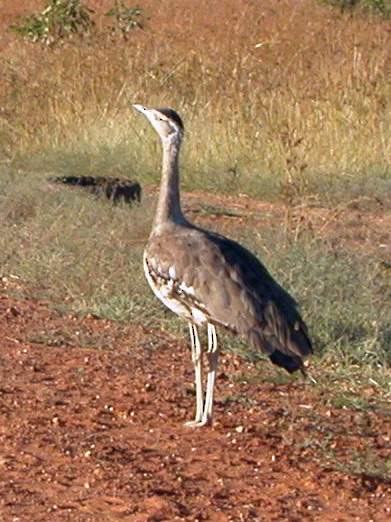Australian Bustard
From Wikipedia, the free encyclopedia
Order: Gruiformes
Family: Otididae
[Photo] Australian Bustard (Ardeotis australis), Chillagoe, Australia. Date April 2004. Author Glen Fergus (http://commons.wikimedia.org/wiki/User:Glen_Fergus)
The Australian Bustard, Ardeotis australis, is a large ground bird of grassland, woodland and open agricultural country across northern Australia and southern New Guinea. It is also commonly referred to in Central Australia as the Bush Turkey, particularly by Aboriginal people.
The male is up to 1.2 m (nearly 4 ft) tall with a 2.3 m (7.6 ft) wingspan. The female is quite a bit smaller (80 cm/32 in) but is similarly coloured. The back, wings and tail are dull brown, with mottled black and white markings on the wing coverts. The neck and head appear dull white and the crown black. Legs are yellow to cream coloured.
When disturbed, Australian Bustards often adopt a cryptic pose with neck erect and bill pointed skywards. They may stalk gradually away or run if alarmed, taking flight as a last resort. Populations are highly romantic following rain and feed, which includes seeds, fruit, centipedes, insects, molluscs, lizards, young birds and small rodents.
Conservation Status
This bird remains relatively common and widespread across most of northern Australia (see Atlas), but its range appears to have contracted in the south-east of the continent during the last century, perhaps due to hunting (now illegal except for indigenous Australians), feral predators such as pigs and foxes and habitat destruction. Its nomadic habits make it difficult to assess.
The Australian Bustard is not listed as threatened on the Environment Protection and Biodiversity Conservation Act 1999.
Victoria
The Australian Bustard is listed as threatened on the Victorian Flora and Fauna Guarantee Act 1988. Under this Act, an Action Statement for the recovery and future management of this species has been prepared.
On the 2007 advisory list of threatened vertebrate fauna in Victoria, this species is listed as critically endangered.
Aborigines and Bush turkeys
Australian Aborigines generally refer to this bird as the Bush Turkey. It is an important food source for Aboriginal people from Central Australia, and is still eaten today. The white feathers of the bird are used for ceremonial purposes.
The Arrernte name for this bird is kere artewe. The Luritja name is kipara .
There are important Dreaming stories associated with the Bush Turkey. A number of artists painting in the desert today paint bush turkey Dreaming. This means they have been given stories of the origins of the turkey in the Dreamtime and are entitled to tell this story and paint about it.
http://en.wikipedia.org/wiki/Australian_Bustard
| The text in this page is based on the copyrighted Wikipedia article shown in above URL. It is used under the GNU Free Documentation License. You may redistribute it, verbatim or modified, providing that you comply with the terms of the GFDL. |
|

